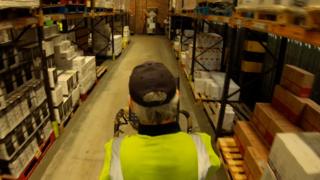Brexit stockpiling warning: UK warehouses already ‘full’

UK warehouses are “full”, raising doubts about the ability of UK firms to stockpile goods ahead of a potential no-deal Brexit on 31 October.
“There is no available space,” Peter Ward of the United Kingdom Warehousing Association (UKWA) told BBC Newsnight.
The estimated vacancy rate for warehouses of over 100,000 square feet nationwide for the second quarter is 6.8%, data seen by Newsnight shows.
In the “inner M25” area the vacancy rate has fallen to just 2.2%.
The nationwide figure is slightly up on last year but, according to experts, still suggests virtually no spare capacity to cope with additional stockpiling.
A decade ago, the national vacancy rate was as high as 23%.
“The market, as represented by our members, is full,” said Mr Ward.
Last week, Cabinet Office minister David Lidington said official no-deal preparations by the civil service were being restarted ahead of the new 31 October Article 50 deadline, including attempts to secure “extra warehouse space” for medicines.
A no-deal Brexit is expected to result in new border checks for goods flowing between the UK and the EU. Manufacturers and supermarkets have been put under pressure to stockpile goods and components to avoid shortages in shops and industrial disruption.
The favourite for the Tory leadership, Boris Johnson, has said the UK will leave the EU on 31 October “come what may”, even if that means a no-deal Brexit.
Richard Sullivan and Kevin Mofid of Savills – who compiled the warehouse data – said there were long-term demand pressures on UK warehousing. This is in part due to the rise of e-commerce, which requires more warehousing than traditional retailing and also because new available land in recent years has been used for residential development.
‘Timing couldn’t be worse’
They said that before March there hadn’t actually been a spike in firms taking any extra warehouse space, despite widespread stockpiling activity, and that this was because firms had used their buffer space on their existing estates.
“Anything below 10% is a landlord’s market,” they added.
But industry experts said it would be much harder for companies to tap this spare capacity this time around because many warehouses will be filling up anyway ahead of “Black Friday” and Christmas retailing.
“The biggest concern at the moment is that the October deadline comes right bang in the middle of peak season. From a timing point of view it couldn’t be worse,” said Mr Ward of the UKWA.
UK warehouse vacancy rate
Units over 100,000 square foot
Savills estimates that around 7.5 million square feet of warehouse space is currently under construction, but this is equivalent to just 1.4% of the total capacity of around 514 million square feet.
“You can’t just turn on supply. Putting real estate in the system takes five to seven years. I can’t see any increase in supply in October relative to March,” said Mr Ward.
A letter sent from the Department of Health and Social Care to medicine suppliers last week said: “While the predicted flow rate across the short straits [crossings into Dover and Folkestone] has improved slightly since 29 March, significant disruption would be expected for six months following a no-deal exit, with the most severe period being the first three months.”
It said that pharmaceutical firms should stockpile six weeks more stock than normal.
Regional warehouse vacancy rate
Q2 2019
You can watch Newsnight on BBC Two weekdays at 22:30 or on iPlayer, subscribe to the programme on YouTube and follow it on Twitter.



